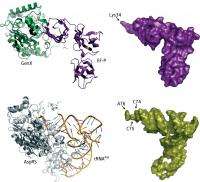Copycat protein finds a perfect match

As proteins are synthesized during messenger RNA translation, fresh amino acids are delivered to the ribosome of the cell by nucleic acid molecules known as transfer RNAs (tRNAs). Each amino acid has a cognate tRNA, and the two are joined by specialized enzymes known as aminoacyl-tRNA synthetases (aaRS).
Scientists have also identified a number of bacterial aaRS paralogs, counterparts that resemble these enzymes but lack key functional domains. The role of these proteins is mostly a mystery, but a team led by Shigeyuki Yokoyama at the RIKEN Systems and Structural Biology Center in Yokohama has now revealed an unexpected function for the Escherichia coli aaRS paralog GenX.
“I thought that elucidation of the structure and function of aaRS paralogs would lead to an understanding of not only mechanisms of genetic code translation but also the evolution of living organisms,” explains Yokoyama. In fact, GenX is closely related to the aaRS that transfers the amino acid lysine; although it can no longer bind lysine’s tRNA, it still associates strongly with lysine, and on the whole these two proteins are highly similar in structure.
This similarity suggested to the team that GenX transfers lysine to a different molecular target, subsequently identified as elongation factor P (EF-P): a translation-associated protein whose structure closely resembles the distinctive L-shape of tRNA molecules. “This is the first discovery of such striking similarities in structure and function between a nucleic acid and a protein, although they are completely different molecules,” says Yokoyama. He proposes that these two molecules may have come to resemble each other by a process of ‘convergent evolution’, which favored the ability to productively interact with such closely related enzymes (Fig. 1).
Although it is extremely common for one protein to modulate the activity of another by attaching one of a selection of chemical groups, this represents the first known example of a protein being modified by the enzymatic addition of an entire amino acid. Nevertheless, the researchers demonstrated that this activity plays a vital role in protein production by E. coli cells, and is therefore essential to their survival.
Yokoyama now hopes to more closely explore the details of this process, but he also sees the potential for short-term applications as well. “GenX exists only in bacterial species, such as E. coli and Salmonella, and not in eukaryotic organisms, such as humans,” he says. “Therefore, GenX is a promising target for developing new antimicrobial agents for pathogenic bacteria … without adverse side effects.”
More information: Yanagisawa, T., Sumida, T., Ishii, R., Takemoto, C. & Yokoyama, S. A paralog of lysyl-tRNA synthetase aminoacylates a conserved lysine residue in translation elongation factor P. Nature Structural & Molecular Biology 17, 1136–1143 2010.
Provided by RIKEN
















